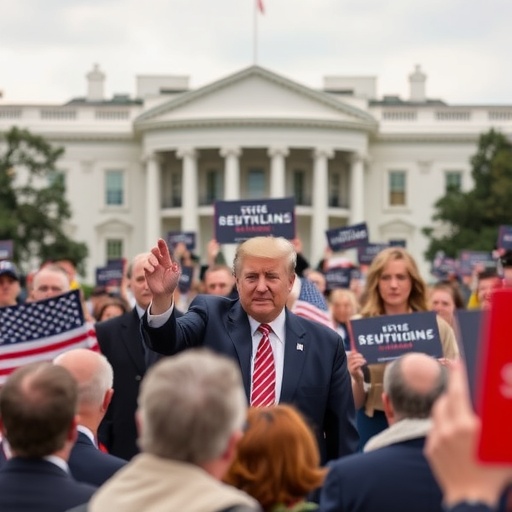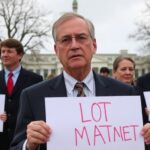Senate Republicans Rally at White House as Government shutdown Enters Fourth Week, Deepening National Crisis
In a bold display of solidarity, Senate Republicans convened at the White House on Tuesday, joining forces with President Trump to reinforce their unyielding position on border security amid a Government shutdown that has now stretched into its fourth grueling week. As federal workers face unpaid wages and essential services teeter on the brink, this gathering underscores the deepening partisan divide that’s leaving millions of Americans in limbo.
- Senate Republicans Unite in White House Showdown Against Shutdown Backlash
- President Trump’s Border Wall Demands Fuel Prolonged Government Shutdown Standoff
- Democrats Intensify Calls for Negotiations to End Devastating Government Shutdown Impacts
- Federal Workers and Economy Reel from Extended Government Shutdown Fallout
- Pathways to Resolution: Bipartisan Talks and Potential Shutdown Endgames Emerge
Senate Republicans Unite in White House Showdown Against Shutdown Backlash
The atmosphere at the White House was electric as over two dozen Senate Republicans, including key figures like Majority Leader Mitch McConnell and Judiciary Committee Chairman Lindsey Graham, filed into the Oval Office for what insiders described as a ‘war council’ meeting. President Trump, flanked by his top advisors, addressed the group with characteristic fervor, emphasizing that the Government shutdown—now the longest in U.S. history at 24 days—stems directly from Democrats’ refusal to fund border wall construction.
“We’re standing strong for the American people and our national security,” Trump declared in a statement released shortly after the meeting. “The Democrats want open borders; we want safety. This shutdown ends when they come to the table.” The rally served not just as a pep talk but as a strategic pivot, with Republicans coordinating messaging to counter growing public frustration over the impasse.
According to a White House official speaking on condition of anonymity, the session focused on legislative tactics to pressure House Democrats, who control the lower chamber. Senate Republicans, holding a slim majority, have repeatedly blocked funding bills that omit wall provisions, mirroring the president’s demands. This unity comes at a critical juncture, as polls from Gallup show approval for Trump’s handling of the shutdown dipping to 35%, with 62% of Americans blaming both parties but leaning toward Democrats in the blame game.
The gathering also highlighted internal GOP dynamics. Senators from border states like Ted Cruz of Texas voiced strong support, citing constituent stories of increased illegal crossings. “This isn’t about politics; it’s about protecting our communities,” Cruz told reporters outside the White House gates. Meanwhile, moderates like Susan Collins of Maine expressed cautious optimism for a compromise but reaffirmed their loyalty to the party’s stance.
President Trump’s Border Wall Demands Fuel Prolonged Government Shutdown Standoff
At the heart of this escalating government shutdown lies President Trump’s insistence on $5.7 billion for border wall funding, a promise central to his 2016 campaign. The White House has framed the shutdown as a necessary stand against what Trump calls a ‘Democrat hoax’ on immigration. In recent days, Trump has escalated rhetoric, tweeting that “Democrats are holding our military and federal workers hostage” over what he deems essential security measures.
Historical context reveals this isn’t the first such impasse. The current shutdown, which began on December 22, 2018, over a spending bill disagreement, has furloughed 800,000 federal employees and forced another 400,000 to work without pay. The economic toll is mounting: the Congressional Budget Office estimates a $11 billion hit to the U.S. economy in the first quarter of 2019 alone, including lost productivity and delayed IRS refunds.
Trump’s strategy appears multifaceted. By rallying Senate Republicans at the White House, he’s leveraging the venue’s symbolism to project strength. Advisors have floated ideas like declaring a national emergency to redirect funds, a move that could bypass Congress but risks legal challenges. During the meeting, Trump reportedly urged senators to prepare for a prolonged fight, warning that any concession would embolden Democrats ahead of the 2020 elections.
Public reaction has been mixed. A Pew Research Center survey indicates 47% of Republicans support the shutdown if it secures wall funding, compared to just 9% of Democrats. Veterans’ groups and federal unions, however, have mobilized protests, with the American Federation of Government Employees reporting over 10,000 members affected by delayed paychecks. One furloughed TSA worker, Maria Gonzalez from Virginia, shared her plight: “I voted for Trump, but this shutdown is hurting my family. We need a solution now.”
Democrats Intensify Calls for Negotiations to End Devastating Government Shutdown Impacts
Across the aisle, Democrats are ramping up pressure for bipartisan talks, portraying the government shutdown as a Republican-engineered crisis. House Speaker Nancy Pelosi, in a fiery floor speech, accused President Trump of prioritizing ‘a medieval wall’ over American families. “This shutdown is hurting real people—our troops, our coast guard, our air traffic controllers,” Pelosi stated, vowing that Democrats won’t budge on wall funding until a comprehensive immigration deal is reached.
The Democratic strategy centers on passing clean funding bills in the House, which have garnered overwhelming support but stall in the Republican-led Senate. Senate Minority Leader Chuck Schumer has been vocal, tweeting, “President Trump and Senate Republicans must end this shutdown farce. Millions suffer while they play politics at the White House.” Democrats point to data from the U.S. Conference of Mayors, which warns of $2 billion in lost local tax revenue due to the shutdown’s ripple effects on tourism and small businesses.
In a bid to humanize the crisis, Democrats have spotlighted stories from affected communities. For instance, national parks like Yosemite have seen closures, leading to an estimated $76 million loss in visitor spending per the National Park Service. Coast Guard families, working without pay, have turned to food banks, with reports from Operation Blue Shield indicating over 5,000 households seeking aid.
Key Democratic senators, including Cory Booker and Kamala Harris—both eyeing 2020 presidential runs—attended counter-rallies near the Capitol, urging Senate Republicans to break ranks. “Unity at the White House shouldn’t mean unity in suffering,” Booker remarked. Yet, internal Democratic divisions linger, with some moderates like Joe Manchin of West Virginia advocating for incremental compromises to avoid electoral backlash in red states.
Federal Workers and Economy Reel from Extended Government Shutdown Fallout
The human cost of the government shutdown is perhaps its most poignant chapter, with over 2.1 million federal workers and contractors bearing the brunt. In its fourth week, the crisis has triggered widespread financial strain: rent delinquencies among federal employees have surged 20% in shutdown hotspots like Washington, D.C., according to Zillow data. Food pantries in the capital report a 30% uptick in visits from government workers.
Economic analysts warn of broader repercussions. Moody’s Analytics projects that if the shutdown persists into February, GDP growth could shave off 0.5 percentage points for the year. Small businesses dependent on federal contracts, such as those supplying the Pentagon, face bankruptcy risks; the Small Business Administration notes delays in loan processing exacerbating the pain.
International impacts are emerging too. The State Department has halted visa processing in many countries, stranding U.S. allies and tourists. At the White House rally, Senate Republicans acknowledged these strains but pivoted to immigration stats: U.S. Customs and Border Protection reported 52,000 apprehensions in December alone, bolstering their argument for wall funding.
Personal narratives amplify the urgency. Eric Smith, a Smithsonian curator furloughed without pay, told CNN, “Museums are dark, research halted— this shutdown isn’t just political; it’s paralyzing progress.” Support networks have sprung up, with GoFundMe campaigns raising over $1 million for federal workers, highlighting community resilience amid partisan gridlock.
Pathways to Resolution: Bipartisan Talks and Potential Shutdown Endgames Emerge
As the government shutdown drags on, glimmers of negotiation appear on the horizon. Backchannel discussions between moderate senators from both parties suggest a possible framework: tying border security enhancements to humanitarian aid for migrants, potentially unlocking funding without full wall allocation. President Trump has hinted at flexibility, stating in a Fox News interview, “I’d consider alternatives if Democrats show good faith.”
Senate Republicans, fresh from their White House huddle, are preparing to vote on a compromise bill next week, though passage remains uncertain. Democrats, meanwhile, are leveraging public opinion— a Quinnipiac poll shows 53% favor ending the shutdown unconditionally—to force concessions. Legal experts speculate that court challenges to any emergency declaration by Trump could accelerate talks.
Looking ahead, the shutdown’s legacy could reshape midterm dynamics and 2020 prospects. If resolved soon, Republicans might claim victory on security; prolonged chaos risks alienating independents. Bipartisan groups like No Labels are calling for a ‘grand bargain’ on immigration reform, including DREAMer protections in exchange for infrastructure investments.
Ultimately, the White House rally signals Senate Republicans’ commitment to standing with President Trump, but mounting pressures from the economy and public sentiment may compel all sides toward the negotiating table. For millions awaiting paychecks and stability, the clock is ticking toward a resolution that balances security with compassion.









